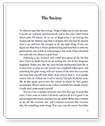Essay Instructions: This assignment is for Pheelyks.(related to order #107740)
ASSIGNMENT:
Read the assigned reading and see the required film, keep notes, then write a thoughtful, formal response. Be mindful to cite specific passages from the texts to support your assertions and your main points. Cite the texts assigned and refer to specific incidents in the films. You do not need outside web sources, such as Wikipedia, though they are acceptable if used with care.
DISCUSSION:
There is a character missing in the film version of The Taming of the Shrew, Christopher Sly, and his absence underlines the importance of the issue of “mediated” interactivity we discussed in the last unit. The character of Sly serves as a framing narrative device in the play, although an incomplete one because he does not return at the end of the play to provide closure of the device. As a frame, the entire story of the shrew, Kate, is a story within a story, which makes the frame extremely important, though not very long. What do you make of this character? What to you make of his name—is it a “transparency, that is, a name that tells us something about his character? What is the purpose of a framing story in general and in this play in particular? Is the dramatic structure of The Taming of the Shrew faulty because the frame isn't closed? If you haven't seen the film The War of the Roses, see it and study the role of the lawyer who tells the story and his role in it, then apply this understanding to The Taming of the Shrew. In connection to the discussion in Unit 1, how do you account for Sly as an example of an interactive character and just how is this relationship with the audience created by Shakespeare?
Again and again, Shakespeare's plays, both tragedies and comedies, begin with a conflict between a father, demanding filial rights, and his daughter, demanding her freedom and individuality. In many ways, many of Shakespeare's views on women are modern—and he is different from other writers of his time on this subject. At the same time, some feminist critics view The Taming of the Shrew as a male-chauvinist play, one that exchanges one male domination for another, the husband replacing the father. Either interpretation depends on how the play is read, interpreted and performed. In the Burton-Taylor version of the film that you have watched, are those scenes in which Kate accepts Petruchio's absurd controls (for example, the sun is the moon, if he says so) proof of women's intelligence or as proof of submission? Does this film's interpretation of the play conform to your reading of the text? How? Why? What was Shakespeare advocating in this play? Are scenes such as these tongue-in-cheek, ironic, or are they lessons on a woman's “proper” role in marriage?
READING
Riverside:
Twentieth-Century Shakespeare Criticism, pp. 27-44;
Introduction to “The Taming of the Shrew,” pp. 138-141;
“The Taming of the Shrew,” pp. 142-176.
Cambridge Companion:
The Genre's of Shakespeare's Plays" (83-98);
"The London Scene,: City and Court" (115-128)
FILM
“The Taming of the Shrew” (Director, Franco Zeffirelli, with Elizabeth Taylor, Richard Burton, 1967).
WEB SITES
Metaphor and the Shrew
http://www.geocities.com/SoHo/Cafe/2759/shrew.html
The Searchable Shrew
http://www.online-literature.com/shakespeare/shrew/


